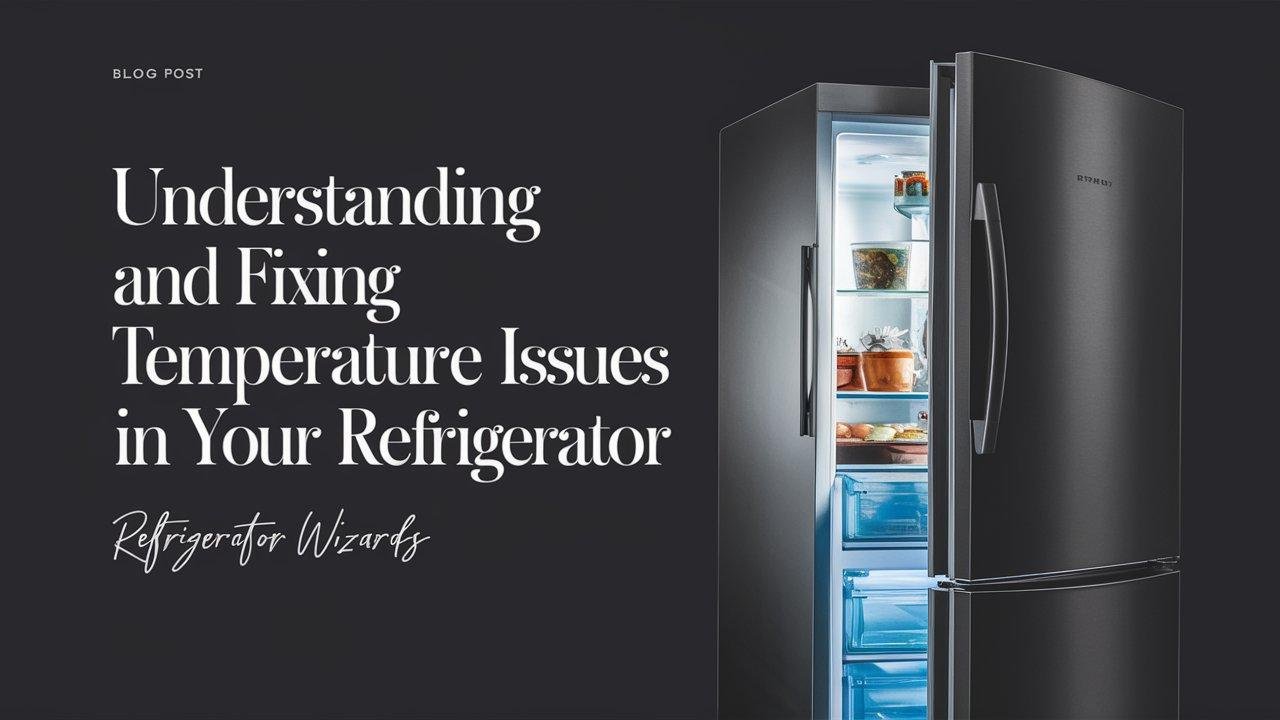A properly functioning refrigerator is crucial for food safety and energy efficiency in any household. When temperature issues arise, they can lead to spoiled food, increased energy bills, and potential health risks. They can stem from various sources, from simple user errors to complex mechanical failures. Understanding these issues is the first step in resolving them, potentially saving you from costly repairs or premature replacement. Plus, knowing how to address them can save you money and prevent food waste.
Signs of Temperature Issues in Your Refrigerator
It’s important to recognize the signs that your refrigerator is experiencing temperature problems:
- Food spoiling faster than usual
- Ice cream that’s too soft or melting
- Excessive frost buildup in the freezer
- Condensation or water droplets inside the refrigerator
- The refrigerator feels warm to the touch on the outside
- Your energy bills have unexpectedly increased
If you notice any of these signs, it’s time to investigate further and take action.
Understanding Ideal Refrigerator Temperatures
Knowing the correct temperature ranges for your refrigerator and freezer is essential:
- Refrigerator compartment: 35°F to 38°F (1.7°C to 3.3°C)
- Freezer compartment: 0°F (-18°C) or below
CLT Appliance Repair technicians recommend using a separate thermometer to verify your refrigerator’s internal temperature, as built-in displays may not always be accurate.
Read More Article: The Role of Box Truck Dispatchers in Supporting Small and Medium-sized Businesses
Common Causes of Temperature Issues
Several factors can contribute to temperature problems in your refrigerator:
- Dirty Condenser Coils
Condenser coils release heat from the refrigeration system. When they’re covered in dust and debris, they can’t efficiently dissipate heat, causing the refrigerator to work harder and struggle to maintain proper temperatures.
How to fix:
- Unplug the refrigerator
- Locate the coils (usually at the back or bottom of the unit)
- Use a coil brush or vacuum attachment to clean the coils thoroughly
- Plug the refrigerator back in and monitor the temperatures
Regular cleaning of condenser coils can significantly improve your refrigerator’s efficiency and performance.
- Faulty Door Seals
Door seals, or gaskets, create an airtight seal when the refrigerator door is closed. If they’re damaged or dirty, cold air can escape, making it difficult for the refrigerator to maintain proper temperatures.
How to check and fix:
- Inspect the seals for cracks, tears, or food debris
- Clean the seals with warm, soapy water and dry them thoroughly
- Test the seal by closing the door on a dollar bill – if it slides out easily, the seal may need replacement
- If replacement is necessary, contact a refrigerator repair Charlotte NC service for professional assistance
- Blocked Vents
Refrigerators circulate cold air through vents. If these vents are blocked by food items, it can lead to uneven cooling and temperature issues.
How to fix:
- Locate the vents in your refrigerator and freezer compartments
- Ensure there’s adequate space around the vents for air circulation
- Rearrange food items to avoid blocking the vents
- Avoid overpacking your refrigerator
- Malfunctioning Thermostat
The thermostat controls the refrigerator’s cooling cycles. If it’s not working correctly, it can cause temperature fluctuations.
How to check:
- Adjust the thermostat to the coldest setting
- Listen for a click sound, indicating the compressor is engaging
- If you don’t hear a click or notice no change in cooling, the thermostat may be faulty
Replacing a thermostat often requires professional expertise. Consider contacting an appliance repair Charlotte service for assistance.
- Defrost System Problems
Many modern refrigerators have automatic defrost systems. If this system malfunctions, it can lead to frost buildup and temperature inconsistencies.
Signs of defrost system issues:
- Excessive frost in the freezer
- Water pooling at the bottom of the refrigerator
- Uneven cooling in the refrigerator compartment
Fixing defrost system problems usually requires professional intervention.
- Compressor Issues
The compressor is the heart of your refrigerator’s cooling system. If it’s not functioning properly, it can lead to significant temperature problems.
Signs of compressor issues:
- The refrigerator is not cooling at all
- You hear a buzzing or clicking sound, but the compressor doesn’t start
- The compressor runs constantly without cycling off
Compressor repairs or replacements should be handled by experienced professionals due to the complexity and potential safety hazards involved.
- Low Refrigerant Levels
While less common in modern sealed systems, low refrigerant levels can cause cooling problems in older refrigerators or those with leaks.
Signs of low refrigerant:
- The refrigerator runs constantly but doesn’t cool properly
- You notice a hissing sound near the compressor
Refrigerant handling requires specialized equipment and expertise. Always consult a refrigerator repair Charlotte NC professional for refrigerant-related issues.
Read More Article: Best Practices for Securing Loads in Flatbed Truck Freight
DIY Troubleshooting Steps
Before calling for professional help, try these troubleshooting steps:
Check the power supply and settings:
- Ensure the refrigerator is plugged in and the outlet is working
- Verify that the temperature settings are correct
- Make sure the refrigerator is not in demo or showroom mode
Inspect and clean the door seals:
- Clean the gaskets with mild soap and water
- Check for any visible damage
Clean the condenser coils:
- Refer to your user manual for coil location and cleaning instructions
- Use a coil brush or vacuum attachment to remove dust and debris
Check for airflow obstructions:
- Ensure vents are not blocked by food items
- Maintain proper spacing between items for air circulation
Inspect the defrost drain:
- Look for any blockages in the defrost drain
- Clear any debris to prevent water accumulation
Wrapping Up
Promptly addressing temperature issues in your refrigerator is crucial. Delaying repairs can lead to:
- Increased energy consumption and higher bills
- Potential food safety risks
- More extensive and costly damage to the appliance
If you’re uncomfortable performing DIY troubleshooting or repairs, don’t hesitate to contact a professional. Many appliance repair services offer expertise beyond refrigerators. For instance, if you’re also experiencing issues with other household appliances, you might want to inquire about clothes dryer repair Charlotte NC services as well.
CLT Appliance Repair specializes in diagnosing and resolving refrigerator temperature issues. Our team of experienced technicians is equipped with the knowledge and tools to quickly identify the root cause of temperature problems and provide effective solutions. We offer comprehensive repair services for all major refrigerator brands and models, ensuring your appliance operates at peak efficiency.




